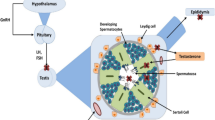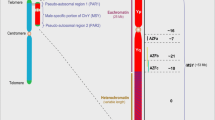Abstract
The synthetic androgen 17β-trenbolone (β-TBOH), used as a growth promotant in cattle, and its metabolite 17α-trenbolone (α-TBOH) were tested for genetic toxicity in Syrian hamster embryo (SHE) cells and in mouse C3H10T1/2 embryo fibroblasts by measuring the induction of micronucleus formation and neoplastic cell transformation. Both β-TBOH and α-TBOH, but not testosterone nor its hormonally active metabolite, 5α-dihydrotestosterone, caused a dose-related induction of micronuclei in SHE cells. In C3H10T1/2 cells, neither β-TBOH nor α-TBOH gave rise to micronucleus induction. Further more, both β-TBOH and α-TBOH, but not testosterone, were found to transform SHE cells but not C3H10T1/2 cells morphologically. The β-TBOH-transformed SHE cells proved to be neoplastic in thymus-aplastic nude mice. These data show that β-TBOH is able to cause changes at the chromosomal level and neoplastic transformation independent of its hormonal activity in one mammalian cell system but not in another one. The implications of these data for the risk evaluation of β-TBOH are discussed.
Similar content being viewed by others
Abbreviations
- TBOH:
-
trenbolone, 17-hydroxy-4,9,11-androstat-rien-3-one
- DES:
-
diethylstilbestrol, E-3,4-di(p-hydroxyphenyl) hex-3-ene
- DMSO:
-
dimethylsulfoxide
- PCS:
-
fetal calf serum
- PBS:
-
phosphate-buffered saline pH 7.4 (0.14 MNaCl, 3 mM KCl, 8 mM Na2HPO4, 1 mM KH2PO4)
- SHE:
-
Syrian hamster embryo
References
Barraud B, Lugnier A, Dirheimer G (1984) Determination of the binding of trenbolone and zeranol to rat-liver DNA in vivo as compared to 17β-oestradiol and testosterone. Food Addit Contam 1: 147–155
Barrett JC, Wong A, McLachlan JA (1981) Diethylstilbestrol induces neoplastic transformation without measurable gene mutation at two loci. Science 212: 1402–1404
Berwald Y, Sachs L (1965) In vitro transformation of normal cells to tumor cells by carcinogenic hydrocarbons. J Natl Cancer Inst 35: 641–657
DiPaolo JA, Nelson RL, Donovan PJ (1971) Morphological, oncogenic and karyological characterization of Syrian hamster embryo cells transformed in vitro by carcinogenic polycyclic hydrocarbons. Cancer Res 31: 1118–1127
Hoffmann B, Evers P (1986) Anabolic agents with sex hormone like activities: problems of residues. In: Rico AG (ed) Drug residues in animals. Academic Press Inc, New York, pp 111–146
Ingerowski GH, Scheutwinkel-Reich M, Stan HJ (1981) Mutageni city studies on veterinary anabolic drugs with the Salmonella/ microsome test. Mutat Res 91: 93–98
Lutz WK, Caviezel M, Marinovich M, Friederich U, Schlatter C (1985) Investigation of mutagenicity and of the potential for binding of trenbolone to DNA in rat liver and in vitro. J Cancer Res Clin Oncol 109: A 16
Kommission der Europäischen Gemeinschaften (1984) Berichte des Wissenschaftlichen Veterinärausschusses, des Wissen-schaftlichen Futtermittelausschusses und des Wissenschaftli-chen Lebensmittelausschusses auf der Grundlage des Berichtes der Wissenschaftlichen Gruppe „Anabolika in der tierischen Erzeugung“, ISBN 92-825-5038-9, EGKS-EWG-EAG, Luxemburg: Amt für amtliche Veröffentlichungen der Euro-päischen Gemeinschaften
Pienta RJ (1980) Transformation of Syrian hamster embryo cells by diverse chemicals and correlation with their reported car cinogenic and mutagenic activities. In: de Serres FJ, Hollaen der A (eds) Chemical mutagens. Principles and methods for their detection. Plenum Press, New York, vol 6, pp 175–202
Pienta RJ, Poiley JA, Lebherz WB III (1977) Morphological transformation of early passage golden Syrian hamster embryo cells derived from cryopreserved primary cultures as a reliable in vitro bioassay for identifying diverse carcinogens. Int J Cancer 19: 642–655
Pottier J, Cousty C, Heitzman RJ, Reynolds IP (1981) Differences in the biotransformation of a 17β-hydroxylated steroid, trenbolone acetate, in rat and cow. Xenobiotica 11: 489–500
Reznikoff CA, Bertram JS, Brankow DW, Heidelberger C (1973) Quantitative and qualitative studies of chemical transformation of cloned C3H mouse embryo cells sensitive to postconfluence inhibition of cell division. Cancer Res 33: 3239–3249
Richold M (1988) The genotoxicity of trenbolone, a syntheti6c steroid. Arch Toxicol 61: 249–258
Schiffmann D, Metzler M, Neudecker T, Henschler D (1985) Morphological transformation of Syrian hamster embryo cells by the anabolic agent trenbolone. Arch Toxicol 58: 59–63
Schiffmann D, Lieb G, Metzler M, Henschler D (1986) Induction of micronuclei in Syrian hamster embryo (SHE) fibroblasts by diethylstilbestrol (DES) and related compounds. Toxicol Lett 31 (Suppl): 204
Schulte-Hermann R, Timmermann-Trosiener I, Schuppler J (1983) Promotion of spontaneous preneoplastic cells in rat liver as a possible explanation of tumor production by non mutagenic compounds. Cancer Res 43: 839–844
Tsutsui T, Maizumi H, McLachlan JA, Barrett JC (1983) Aneu-ploidy induction and cell transformation by diethylstilbestrol: a possible chromosomal mechanism in carcinogenesis. Cancer Res 43: 3814–3821
Author information
Authors and Affiliations
Additional information
This study has been supported by a grant from the Bundesministerium für Jugend, Familie, Frauen und Gesundheit
Rights and permissions
About this article
Cite this article
Schiffmann, D., Hieber, L., Schmuck, G. et al. Trenbolone induces micronucleus formation and neoplastic transformation in Syrian hamster embryo fibroblasts but not in mouse C3H10T1/2 cells. Arch Toxicol 62, 49–53 (1988). https://doi.org/10.1007/BF00316257
Received:
Accepted:
Issue Date:
DOI: https://doi.org/10.1007/BF00316257




